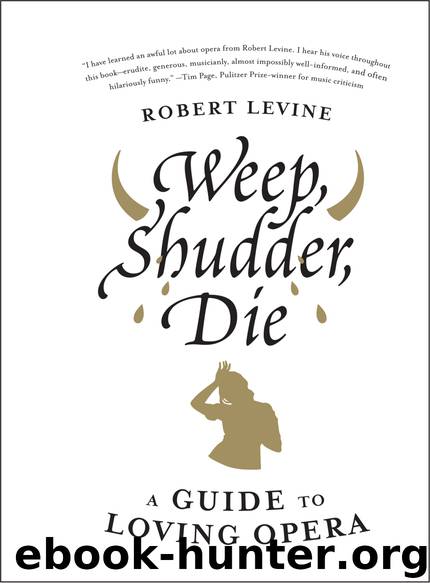Weep, Shudder, Die by Robert Levine

Author:Robert Levine
Language: eng
Format: epub
Publisher: HarperCollins
Norma’s dilemma, knife in hand: Should I kill the kids or give them a hug? Can the audience please vote?
WHAT’S HAPPENING
Gaul, first century B.C.
In Act I, Pollione spies on the Druids as they pray for victory over their Roman masters. He is also inflamed with desire for Adalgisa, who has replaced Norma in his affections. Later, in a scene of revelation, Norma learns about her lover’s betrayal, Adalgisa learns that this same man is the father of Norma’s children, and the women join forces in cursing Pollione.
In Act II, Norma thinks she must kill her children; she cannot, and she asks Adalgisa to care for them. Adalgisa refuses to take them, instead renewing her own vestal vows and attempting to reunite Norma with Pollione. Norma hears that Pollione plans to abduct Adalgisa, and she arranges for him to be burned as a sacrifice to war. However, she makes herself the victim in his place, and Pollione, seeing the nobility of the woman he has rejected, joins her on the pyre.
FAR MORIRE
Act I: Norma’s entrance recitative and aria, “Sediziose voci . . . Casta diva”: the pinnacle of bel canto, a beautiful, long vocal line, gentle and flowing, with exposed ascents to high notes, followed by a fast section that is florid and dramatic at once—possibly the most beautiful and challenging aria and cabaletta in all of opera. Norma and Adalgisa’s duet “O, rimembranza!,” in which Adalgisa tells Norma that she is in love and Norma recalls her own early days of love with Pollione with great sadness; the intermingling of voices is miraculous. The trio finale, “Ma di’: l’amato giovane . . . O non tremare . . . Vanne, sì,” in which the truth is revealed: Pollione is Adalgisa’s lover, and Norma becomes enraged. Theater wedded to music at its most exciting.
Act II: Opening monologue of Norma, as she watches her sleeping children and contemplates murdering them—a portrait of a loving mother’s tormented soul; Norma-Adalgisa duet “Mira, o Norma,” another ravishing example of blended voices; Norma’s vicious revenge scene, the duet “In mia man alfin tu sei,” when Pollione is caught and brought before her; the finale, “Qual cor tradisti,” which is indescribable in its sheer sadness.
Gaetano Donizetti
Another founding bel canto composer, Gaetano Donizetti (1797–1848) was the most prolific, composing about seventy operas. By the start of the twentieth century he was known for only a handful: Lucia di Lammermoor, L’Elisir d’Amore, Don Pasquale, and La Favorita. He composed one of the most celebrated coloratura scenes ever: the heroine’s famous, show-stopping mad scene from Lucia di Lammermoor. This is ironic, as Donizetti himself eventually lost his mind after a long-running battle with syphilis. Born in Lombardy into impoverished circumstances, the young maestro began composing early. Prolific in the Italian mode, he wrote several operas each year, as well as the usual chamber works and vocal music. Notable works other than Lucia include La Fille du Régiment (frequently revived as a showcase for singers, including Natalie Dessay), Anna Bolena, and Lucrezia Borgia (if you notice a theme of strong and/or misunderstood women, you’re not wrong).
Download
This site does not store any files on its server. We only index and link to content provided by other sites. Please contact the content providers to delete copyright contents if any and email us, we'll remove relevant links or contents immediately.
Faust Part 1(460)
The Metropolitan Opera Presents by Wolfgang Amadeus Mozart(427)
Norma Jeane Baker of Troy by Anne Carson(425)
The Bonesetter's Daughter by Amy Tan(419)
Venetian Curiosities by Donna Leon(396)
Weep, Shudder, Die by Robert Levine(370)
The Perfect Wagnerite by George Bernard Shaw(367)
The Metropolitan Opera Presents by Georges Bizet(334)
Music Theory through Musical Theatre: Putting It Together by John Franceschina(281)
A Book of Operas by Henry Edward Krehbiel(277)
Musicality in Theatre by Roesner David(262)
Prepare for Saints: Gertrude Stein, Virgil Thomson, and the Mainstreaming of American Modernism by Steven Watson(262)
Carmen by Prosper Merimee(258)
The Ring of the Niblung by Richard Wagner(245)
Animation, Plasticity, and Music in Italy, 1770-1830 by Ellen Lockhart(208)
Olivier Messiaen's Opera, Saint Francois D'Assise by Vincent Perez Benitez;(196)
